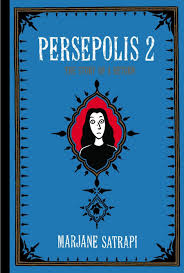Persepolis 2
Listen to the Recess! Clip
| Author | John Cech (read by Jaimy Mann) |
| Air Date | 11/17/2004 |

Persepolis 2 Transcript
One of the most important books to appear this fall for older teens and young adults is the second volume of Marjane Satrapi’s autobiographical graphic novel Persepolis 2. This installment continues Ms. Satrapi’s story about growing up in Iran during that country’s cultural revolution and beyond, through the years of repression that have continued into the present and which made it impossible for Ms. Satrapi to continue to live there. As we follow her training as an art student in Iran, we can certainly sympathize with her growing frustration. She isn’t allowed to draw the female human form, for example, unless it is completely covered. “We nevertheless learned to draw drapes,” she writes, referring to the long black robes that the models in her classes always wore.
But before becoming an art student, she has been in a kind of exile in Europe, sent there by her intellectual parents. Her mother and grandmother want her to fly, to feel the full flush of adolescent independence, and they both tenderly and fiercely offer her their encouragement. Her father supports her years of experimental living in Austria (where she has been sent to boarding school) without question. In fact, he agrees not to ask her anything about what happened to her there after she returns to Iran from school in Vienna — heart-broken, depressed, and physically depleted. She was out of place in Austria, a dark-eyed, dark-haired foreigner. And she is equally out of sync, to say the least, in her brutally repressive homeland. In Austria, no one really seemed to mind what she did. In Iran, people, especially the vigilance committees, care about everything: how much of her forehead and hair appear from underneath her head scarf, the intensity of her laugh, the presence of a Walkman, the color of her socks. “In short,” she writes, “everything was a pretext to arrest us.” What Ms. Satrapi shows us, in her powerfully contrasting black and white drawings is the extent to which she and her friends conduct an everyday, ongoing rebellion against the regime, in their private dress, their hairstyles, the fullness of the individuality that steps forward when they are able to shed their required uniforms and simply be themselves.
This is an astonishing coming-of-age story, especially for a western audience, to be taken behind the veil with such unapologetic directness and unshakable humanity. Her book is sad and funny and deeply moving — often on the same page, often in pictures placed right next to each other, these pieces of the mosaic that Ms. Satrapi is fitting together into an indelible, unforgettable whole.